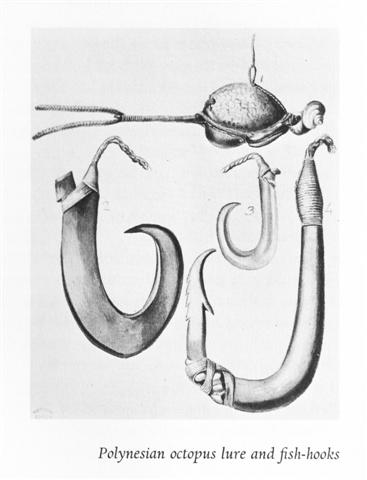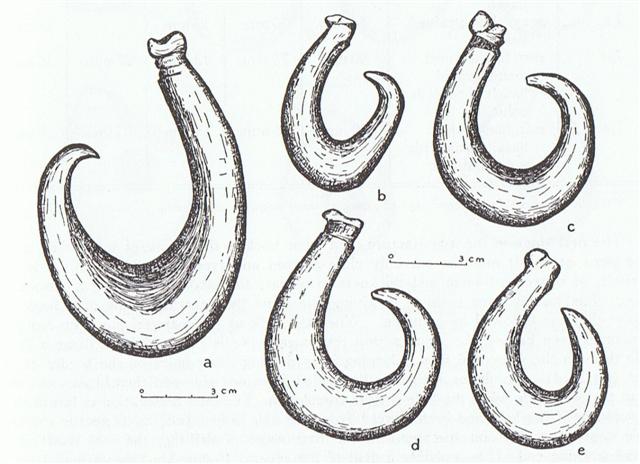But the time of Taurus was in the past. Instead it was Andromeda who functioned as 'fish-lure' for the Sea Beast. This picture is from Antony Alpers' Legends of the South Seas:
The pair of stone figures, buried up to their necks, were apparently only one (like how the pair of Moon faces are not really separate entities, or how Venus as evening star is not really something else than Venus as morning star). ... It grew light on the third day, and again Ira said, 'Go back to swimming on a board, to riding the waves!' All went back out there, and Ira got up. He picked up two stone figures (moai maea) and two mother-of-pearl necklaces (tuitui reipa). The name of the first stone figure was Apina Iti, and the second one was Rapa Kura. Ira took the figures and the ornaments, went on, and came to Apina Iti. He dug a pit, let the figure slide down into the pit, and covered it up with pebbles (kirikiri). The head remained completely free (? he puoko i hakapaka). [I guess there could be a double meaning alluding to 'completely dried out', which seeds should always be before planting.] He put the necklace around the neck of the figure and called the place 'Apina Iti A Rapa Kura' ... Ira gave the stone figure [earlier named Apina Iti] the name 'Hinariru', the name of the master, (son) of Tuu Hokorua, who had given the figure to Ira. He turned around, went on, and entered the cave Pu Pakakina and remained there. All the young men arrived and settled down (to sleep) ... Possibly the stone figures were stone fish-hooks - therefore buried so as not to show their sharp points.
... The pattern of the stone hooks is uniform throughout, the principal variations being in thickness at the bend and in the distance between the point and the shank. Most of the fishhooks have a continous curve, but in one specimen (b) ... the limb from the bend to the point is almost straight. The shank is topped by a knob or projecting ridge with transverse grooves. A depression in the knob divides it into two unequal parts - one rounded, and the other small and sharp ... which is generally toward the point. Below the ridge there is a recess, the inner margin of which is sometimes serrated. The knob so divided strongly resembles the outlines of birds' heads as represented on the tablets ... In Manuscript E we can see when the explorers came to Pu Pakakina: "On the twenty-ninth day of the month of August ('Hora Iti'), they went to Pu Pakakina. They arrived, remained there, and gave the name 'Pu Pakakina A Ira'. They remained one month in Pu Pakakina." In rongorongo times and on Easter Island spring equinox was not in March but in September, when Andromeda was close to the Full Moon:
Possibly, therefore, the right part of Ca1-1 (between the pair of equinoxes) illustrates a kind of vero with a hook at left - a stone figure. Stars were sometimes named 'stones' (Tau-toru, Tau-ono). The myth tellers on Easter Island must have recounted the common Polynesian story of how 'Land' was 'fished up' from the 'Sea'. They must have understood that it was not literally Easter Island which was drawn up but the 'Land' in time (the 'ebb' of the year). "On the 'second list of place names' Apina Nui (number 60) and Rano Raraku (number 30) are exact opposites. The two localities crucial to the stone figures divide the whole cycle and correspond to a reversal of the lunar phase, such as 'last quarter' vs. 'first quarter'. One could almost call the west-east line from Apina Nui to Rano Raraku a 'moai axis', similar in importance to the north-south line from Anakena to Vinapu (ahu axis?)." (The Eighth Island) |


